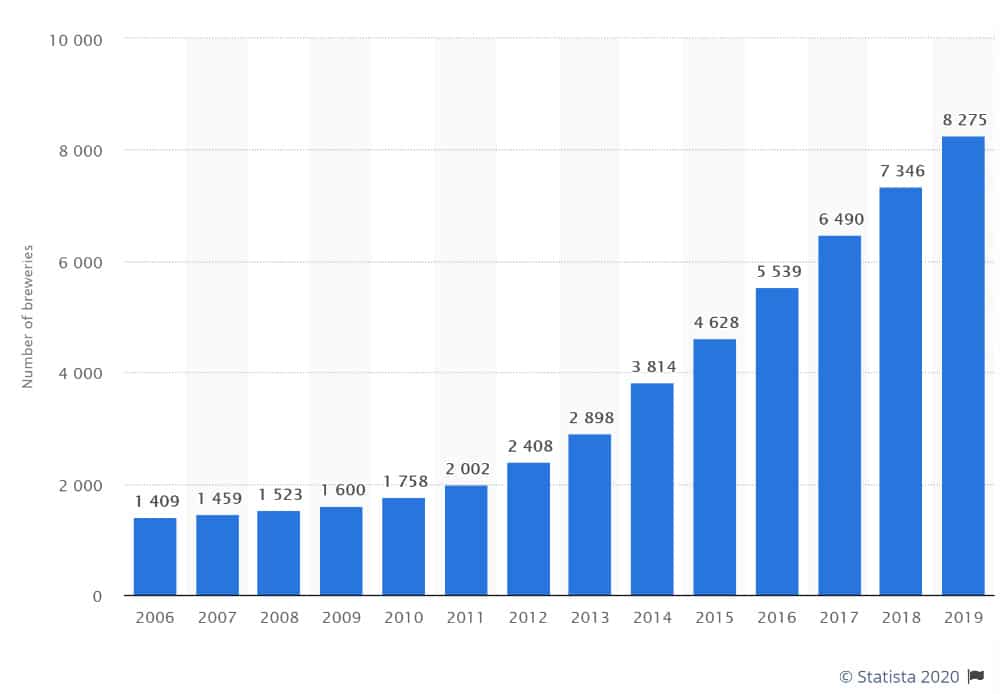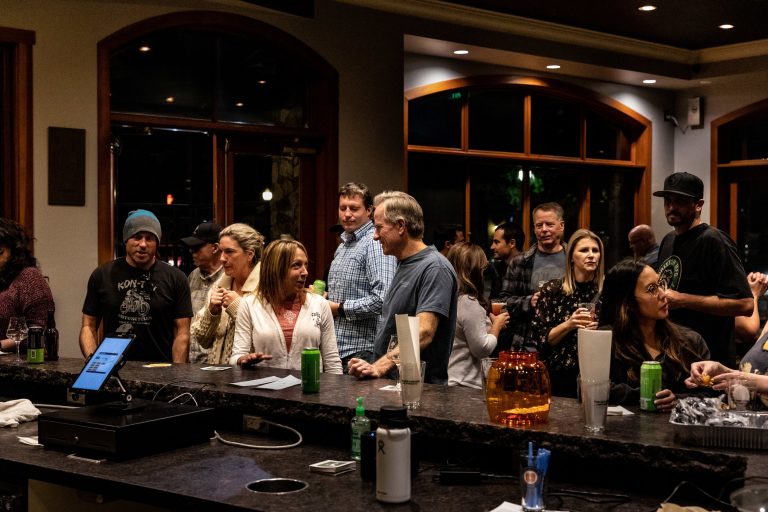Beer Blogging is a Labor of Love
A lot of people love homebrewing their own beer. Even more love drinking it. The craft beer boom over the last decade has brought a huge influx of people into the industry. Just look at the number of microbreweries that have popped up in the last handful of years:

This chart shows the number of operating craft beer breweries in the United States from 2006 to 2019. In 2019, there were a total of 8,275 craft breweries in the United States, accounting for 25.2% of the beer sales market share in the US. $29.3 billion in craft beer was sold in 2019, up 6% over 2018.
Anyone that has visited a brewery in the last handful of years knows this is true. Packed taprooms, lines around blocks for can releases and vacations surrounding brew tours have become commonplace.
The increase of craft beer popularity, brought forth a wave of DIYers that wanted to learn how to brew their own. As with any popular hobby, there’s been a wave of webpreneurs that have seized the opportunity. Some have started their own websites surrounding their love of craft beer, or the making of it – us included.
With hard work and determination, a website as a business can be a successful side hustle or full-fledged business. I also know this first hand as I’ve owned a few over the course of my career online.
How Blogs Make Money
Most blogs and hobby websites makes their money in display advertising and affiliate marketing. If you can manage to get few thousand visitors a month, you can make some pretty good side cash. Get a couple of hundred thousand visitors a month and you may be making more than you’ve ever dreamed of before.
If you aren’t in Ad Tech, the term ‘display advertising’ may seem a bit foreign to you, but you definitely interact with it multiple times daily. Any banner or video ad displayed to a website visitor is a form of display advertising. Website owners are usually paid based on the number of clicks or views of a particular ad is shown to a visitor.
Affiliate marketing is similar, but instead of being shown ads, website owners link to specific products or services with the hope that their visitors will buy it. If they do, a small percentage, usually between 2-15% is paid back to the website owner for their work in producing that sale. This unfortunately can lead to some not so great recommendations. However, I’ve found that for the most part they are safe provided you do some research on your own first.
The Pits of Beer Blogging
Unfortunately, blogging about beer – or any alcohol for that matter – isn’t like owning other websites.
Advertisers don’t like advertising on alcohol-themed websites. Alcohol is considered a controversial topic by many would-be advertisers, so earning any money off display advertising is difficult to say the least.

AdSense is Google’s platform for displaying advertising on blogs like Beer Maverick. It has the lowest barrier of entry, and does a pretty good job of monetizing websites. However, AdSense stacks the deck against beer themed websites.
By default, AdSense blocks ads in the Alcohol “sensitive category” from appearing on your website. If you happen to own a beer or alcohol website and using AdSense, make sure you check on that.
Do this by going to Blocking Controls -> Your Website -> Manage Sensitive Categories and find the toggle switch to allow alcohol ads to appear. This is important because irrelevant ads being displayed on a website annoy users and make virtually nothing for the publisher.
Unfortunately, it gets worse. Advertisers trying to display their ads also have their toggle thrown. This prevents them from showing their ads on alcohol-themed websites. While I understand the initial hesitation, the amount of respectable bloggers is enormous, and we should be trusted more.
So even though you may now have allowed AdSense to display alcohol ads on your site, potential Advertisers may still be ignoring your site.
Due to these restrictions, Beer Maverick and similar beer blogs earn about 90% less in advertising when compared to sites of similar size, but in a different (read: non-sensitive) category.
Many advertising platforms have similar restrictions as AdSense. However, there are some platforms that focus on these sensitive categories. For alcohol, that company is GourmetAds. While they are dedicated to advertising on food- and alcohol-themed websites, they only have marginally better RPMs than AdSense.
Affiliate marketing is a bit easier to find, but not much. Amazon.com is the largest affiliate marketing company, but it only helps a small subset of websites that regularly reference buying brewing and kegging equipment. Craft-beer only bloggers can’t really use Amazon like that.
Adventures in Homebrewing also has an affiliate program, but with the sheer number of local home brew stores and other online supply stores, the amount gained from this program is next to nothing.
Add up all these issues, and it becomes clear that many owners of websites about beer are doing it for the love of the hobby. We make next to nothing for doing what we are doing unless we are huge. Unfortunately even if we do make it to the big time in terms of popularity, we are still earning 90% less than a site of similar size in a different category.
There is a good reasons that many beer-themed websites start out with big aspirations, then quickly die off. It’s hard to continue when you’re making peanuts.
Time To Get Creative
The only way to truely stay in business as an alcohol-themed website is to get creative.
It’s easy to say there is no time for something. If you care about something deep enough, you’ll find the time.
Chadd Balbi, BreweriesinPA.com
Direct advertising sales is a hassle and time-consuming, but is maybe the only option. Reaching out to big players in the beer and brewing world can pay off, but the effort needs to be put in. You need to build media kits, reach out to potential advertisers, manage and follow up on contracts, set pricing, increase pricing, update ads all the while continuing to build your content. Using a service like AdSense takes all that extra work off your hands, but it is not a viable option to those of us in “sensitive” categories.
Shameless plug: If you are an advertiser that wants to work with it… we want to work with you too.
Others in the industry that are established enough have found other ways for getting paid to write. After becoming famous in the industry through their websites, authors like Scott Janish, Michael Tonsmeire, Derek Dellinger and others have found ways to monetize their words by publishing books. Kudos to these guys for taking the initiative, but I don’t think its something many are capable of.
One of the better examples of an independent beer site that has made it work is BreweriesinPA.com. I recently talked with their co-founder Chadd Balbi about what it took for them to stand out from the crowd.
“At first, it was just finding viewership. It can be hard to stand out in a sea of beer blogs, review channels, etc. So finding an audience took a lot of hard work and dedication. I always say that you have to be true to yourself and your audience and the following will come. Continuously focusing on content that is in line with our mission has made it so that not only can our following trust us, but they look forward to what we have to produce.” said Mr. Balbi, when asked what the largest hurdle was in making it all work.
He continued, “[in] the early days were financed out of our own pockets. But since have grown such a large following we have been able to finance a lot of what we do these days through ad revenue. Advertisers see how large our following is, and they want to be a part of it. That money then allows us to put in more resources to make our site and company look as appealing as possible.”
BreweriesinPA.com is a great example of a site that made it work in a crowded landscape, but they are much more the exception than the norm.
While many websites need steady visitor traffic before they see revenue, writing about beer makes it is much more difficult. Even if you stand out from the crowd, it is hard to continue churning out fresh and engaging content when ad revenue super low comparatively to other niches.






